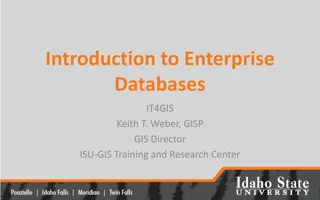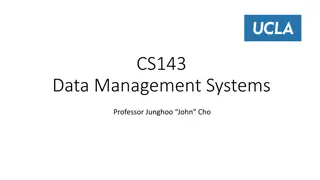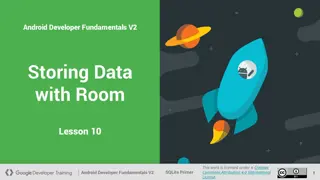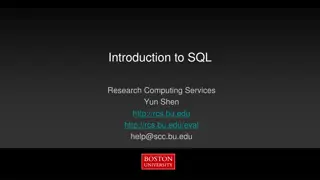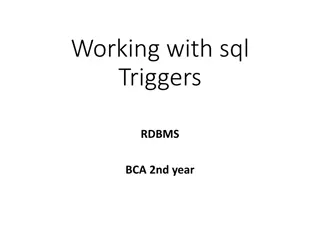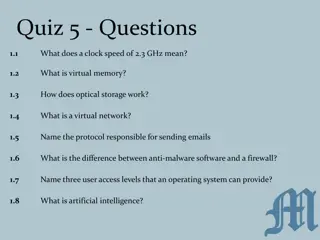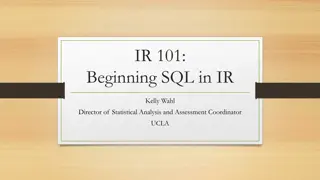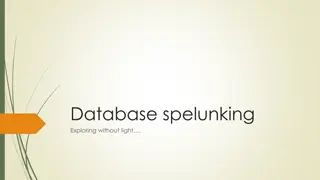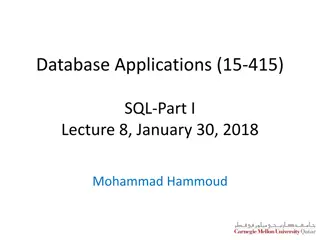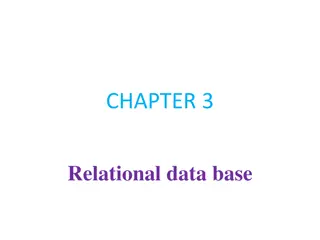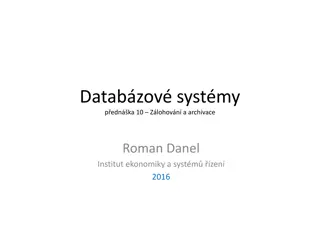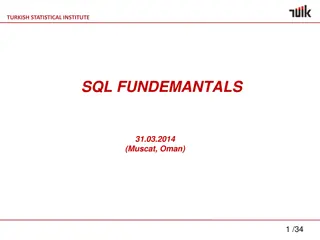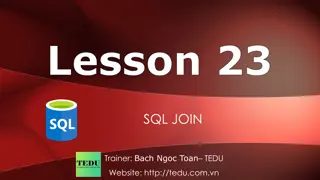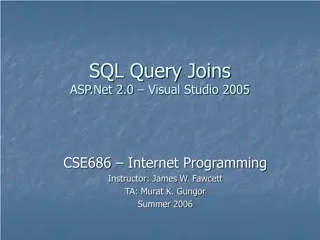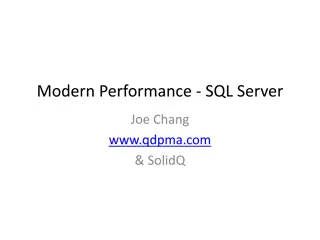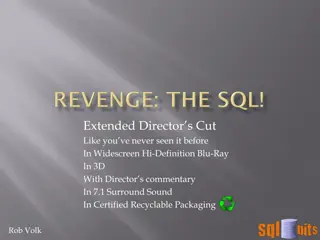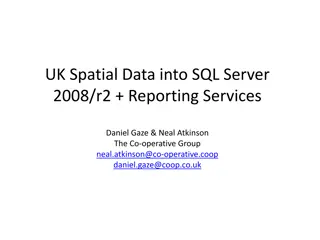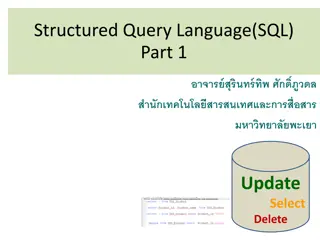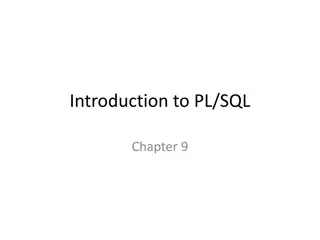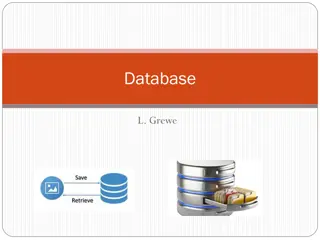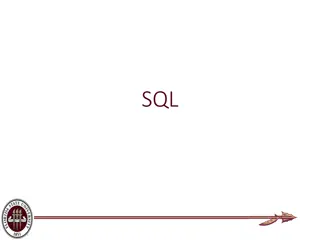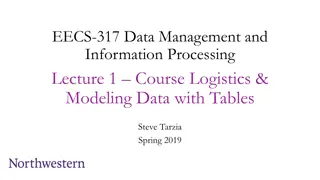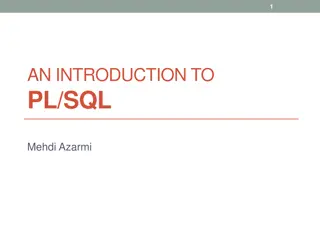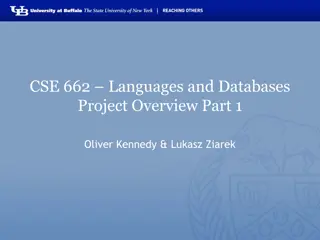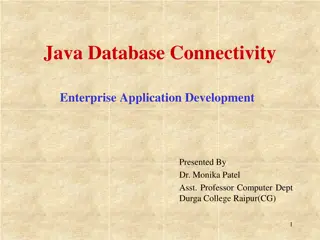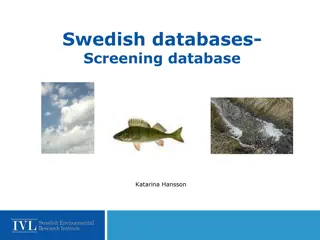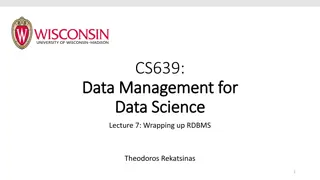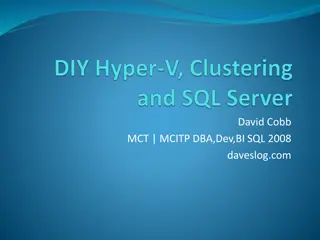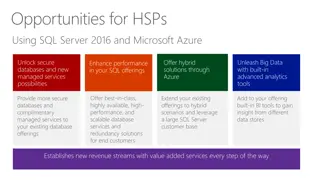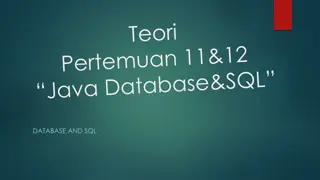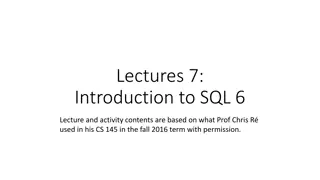Introduction to Enterprise Databases for GIS Professionals
Explore the world of enterprise databases through a GIS perspective with a focus on concurrent clients, database administration, creating databases/tables, checking service names, unique features, numeric data types, data type parameters in ArcGIS, and character data types. Gain insights into managi
1 views • 52 slides
Introduction to CS143 Data Management Systems Course
This course, taught by Professor Junghoo John Cho, covers topics such as data management systems, SQL, RDBMS, and NoSQL databases. Students will learn to store data, interact with databases using SQL, and understand the workings of DBMS. The course objectives, structure, staff information, lecture f
1 views • 21 slides
Exploring the World of Bioinformatics Databases
Bioinformatics databases are essential tools in handling molecular biological data, classified into sequence and structure databases. Primary databases store raw data, while secondary databases contain curated information for research. Examples include GenBank, Protein Data Bank, and SWISS-Prot.
1 views • 38 slides
Database Design Principles and Management Overview
This document presents an overview of database design principles, including structured, semi-structured, and unstructured data types. It delves into the role of Database Management Systems (DBMS) in defining, constructing, manipulating, and sharing databases effectively. It also covers various types
0 views • 47 slides
SQLite and Data Storage with Room in Android Development
SQLite is a self-contained, serverless, and zero-configuration SQL database engine used in Android development. This primer covers how data is stored in tables, columns, and rows, and provides a refresher on SQL databases, assuming familiarity with SQL query language. Room library simplifies SQLite
2 views • 26 slides
Learn SQL Basics: History, Syntax, and Terminology
SQL (Structured Query Language) is a specialized domain-specific language for managing structured data in relational databases. Developed in the 1970s, it follows a rigid syntax and structure, with specific features like triggers and stored procedures. Understanding SQL history, terminology, and syn
1 views • 38 slides
SQL Triggers in Relational Databases
SQL triggers are stored procedures that are automatically invoked when certain events occur in a database, such as insertions or updates to tables. This article explains the definition of triggers, their syntax, types, and examples of DML triggers in SQL servers. It also covers the concept of row-le
5 views • 19 slides
An Overview of Biological Databases in Bioinformatics
Biological databases play a crucial role in bioinformatics, storing vast amounts of data related to nucleotide sequences, protein sequences, and more. These databases are publicly accessible and essential for research in biological fields. Primary databases, such as GenBank, EMBL, and DDBJ, contain
1 views • 13 slides
Comprehensive IT Quiz Questions and Answers
This content provides a quiz format with questions and answers covering various topics in information technology, such as clock speed, virtual memory, optical storage, network concepts, email protocols, cybersecurity tools, operating system access levels, and artificial intelligence. Additionally, i
0 views • 9 slides
Introduction to SQL: Learn the Basics and Beyond
Explore the world of Structured Query Language (SQL) with this comprehensive guide. Discover what SQL is, its history, usage, and how to learn it on your own through free online tutorials. Understand the properties of relational databases and get insights into designing a relational database. With S
0 views • 29 slides
Mastering SQL Server: Tips and Tricks for Efficient Database Exploration
Delve into the world of SQL Server with expert tips on finding instances, listing databases, and searching for tables or columns by name. Discover efficient ways to navigate relational databases using SQL queries, PowerShell, and Management Studio, making database exploration a breeze.
0 views • 14 slides
Introduction to Database Systems and SQL Programming
Understanding database systems is crucial in today's digital world. Explore the basics of database systems, SQL statements, and Java Database Connectivity (JDBC) in this comprehensive overview. Learn about DBMS, SQL querying, JDBC API, and more to enhance your understanding of managing and interacti
10 views • 24 slides
SQL: Major Aspects and Functionality in Database Applications
SQL, as a relational database language, offers Data Manipulation Language (DML) and Data Definition Language (DDL) for querying and modifying data. Additionally, SQL encompasses triggers, embedded code execution, remote database access, transaction management, and security features for efficient dat
1 views • 52 slides
Relational Databases and File-Based Systems
This chapter delves into the fundamental concepts of databases, comparing them to file-based systems, and highlighting the significance of relational databases in modern integrated AISs. It explores the difference between logical and physical views of databases, introduces key concepts such as DBMS
1 views • 70 slides
SQL Functions for Database Queries
SQL functions are essential elements in performing actions and obtaining results in a database query. They come in two main types: scalar functions and aggregate functions. Scalar functions operate on single values, while aggregate functions operate on sets of data. Examples of SQL functions include
1 views • 14 slides
Comprehensive Overview of SQL Commands and Language Categories
In this detailed guide, you will learn about Structured Query Language (SQL) including its various commands such as Data Definition Language (DDL), Data Manipulation Language (DML), Data Control Language (DCL), and Transaction Control Language (TCL). Explore how SQL is used in Database Management Sy
0 views • 15 slides
SQL Server Database Recovery Models and Backup Strategies
Explore the intricacies of SQL Server database recovery models including SIMPLE, BULK-LOGGED, and FULL, along with backup techniques such as full database backups, transaction log backups, and differential backups. Learn about database states, mirror states, and various system databases in SQL Serve
2 views • 24 slides
Turkish Statistical Institute SQL Fundamentals Overview
The Turkish Statistical Institute provides an in-depth look at SQL fundamentals covering main categories, basic SQL commands, set operations, aggregate functions, join operations, and more. SQL, or Structured Query Language, is a special-purpose programming language designed for managing data in RDB
0 views • 33 slides
SQL Part II Lecture Summary: Nested Queries, Joins, and Updates for Database Applications
In this SQL lecture, Mohammad Hammoud covers nested queries, insertion, deletion, updates, handling NULL values, join variants, and advanced query techniques. Examples include finding sailors who have reserved specific boats, using nested queries to filter data, and deep nested queries for complex d
0 views • 53 slides
Database Basics for ASP.NET Development
Explore the fundamentals of databases, SQL usage, database relationships, and available tools for managing database objects in ASP.NET projects. Learn about relational databases, popular database options like Microsoft SQL Server, and setting up SQL Express for local development.
1 views • 27 slides
SQL JOIN: A Comprehensive Guide
SQL JOIN allows you to merge data from multiple tables in a database, enabling you to access information more efficiently. This comprehensive guide covers the types of JOIN operations available in SQL, such as INNER JOIN, LEFT JOIN, RIGHT JOIN, and FULL JOIN, along with their purposes and practical
0 views • 6 slides
SQL Joins in ASP.Net 2.0 with Visual Studio 2005
Exploring the importance of query joins in SQL, this instructional content delves into inner, outer, left outer, and right outer joins for integrating data from multiple database tables in ASP.Net 2.0. Detailed guidance is provided on setting up SQL databases in Visual Studio .NET 2005, creating tab
0 views • 11 slides
Modern Performance in SQL Server
Explore the evolution of performance in SQL Server with insights from Joe Chang, a seasoned SQL Server consultant. Delve into topics like query optimization, execution plans, CPU and memory advancements, storage technologies, and the significance of performance in today's data environment. Discover
0 views • 40 slides
Unorthodox SQL Techniques Unleashed: REVENGE: The SQL
Explore the unconventional realm of SQL with Rob Volk as he delves into extreme methodologies for manipulating data. From revenge-driven practices to extreme server admin tricks, this session is a wild ride through unparalleled SQL strategies.
0 views • 16 slides
Utilizing UK Spatial Data in SQL Server 2008 R2 Reporting Services
Explore how to display UK geospatial data in SQL Server 2008 R2 Reporting Services by finding and importing Ordnance Survey Open Data. Learn how to represent the UK on a map, import data into SQL, and create example reports. Discover limitations and resources to kickstart your spatial data journey i
0 views • 7 slides
Comprehensive Overview of SQL: Commands and Categories
Explore the world of Structured Query Language (SQL) through this detailed guide covering SQL categories, command classifications (DDL, DML, DCL, TCL), data manipulation and control languages, and transaction control language. Learn about creating, altering, and dropping database objects, data retri
0 views • 14 slides
PL/SQL Benefits and Objectives
Explore the advantages of PL/SQL such as integration of procedural constructs with SQL, improved performance, and efficient exception handling. Learn about the objectives of PL/SQL, types of PL/SQL blocks, and using Oracle SQL Developer for development. Gain insights into the structure of PL/SQL blo
0 views • 42 slides
Database Management Systems and Data Storage
Explore the world of Database Management Systems (DBMS) and learn about the evolution of data storage from flat-file to relational databases. Discover the key features of a DBMS, different database types, administration tools, SQL and NoSQL databases, CAP theory, and considerations for choosing betw
1 views • 32 slides
SQL - Introduction and Basics
SQL (Structured Query Language) is a standard language for querying and manipulating data. It includes Data Definition Language (DDL) for creating, altering, and deleting tables, Data Manipulation Language (DML) for querying tables and modifying data, and more. Tables in SQL consist of attributes li
0 views • 30 slides
Handling Complex Data with SQL Databases: A Powerful Foundation for Data Science
Learn how to manage real-world, complex data efficiently using SQL relational databases. Explore the limitations of Excel and Matlab in modeling data relationships and data integrity enforcement. Understand the importance of keeping data and analysis separate. Delve into examples of data sets beyond
1 views • 34 slides
Introduction to PL/SQL: Oracle's Procedural Language Extension
PL/SQL is Oracle's extension to SQL, combining the power of SQL with the procedural constructs of a 3GL. This introduction covers the basics of PL/SQL blocks, block structure, variables and types, executable sections, and example variable declarations. It also highlights the features such as error h
1 views • 29 slides
Introduction to Relational Databases and SQLite for Mobile Computing
Covering the basics of relational databases, SQL, and SQLite, this content provides an overview of database management systems, their history, and the key concepts related to data storage and retrieval. It also touches on the practical aspects of working with SQLite in Android applications, outlinin
2 views • 61 slides
Database Benchmarking: Embedded Databases Comparison
This project involves benchmarking lightweight embedded databases like SQLite, BerkeleyDB, and others. Students will evaluate and compare these databases using specific workloads to analyze their performance. The outcomes include a detailed report on each system's strengths and weaknesses. Required
0 views • 19 slides
Introduction to Java Database Connectivity (JDBC) in Enterprise Application Development
JDBC, or Java Database Connectivity, is a vital technology in enterprise application development that provides a standardized library for Java programs to connect to databases via SQL commands. It abstracts vendor-specific details, making connectivity to multiple databases seamless. JDBC API standar
1 views • 13 slides
Environmental Monitoring and Screening Databases in Sweden
This content delves into the monitoring and screening databases managed by Katarina Hansson at IVL, focusing on chemicals, emissions, and national environmental data in Sweden. It covers the use of national databases, biota databases for pollutants in biological samples, and screening studies involv
1 views • 10 slides
SQL Aggregation and Group By: Understanding Concepts and Examples
Exploring SQL aggregation operations such as AVG, COUNT, and more, along with the GROUP BY clause for grouping data based on specific attributes. Examples illustrate how to use these features effectively in SQL queries to retrieve meaningful insights from databases.
0 views • 44 slides
Active/Active SQL Clusters for High Availability
Discover the importance of Active/Active SQL clusters for ensuring 24/7 availability of your database servers. Learn about the benefits, setup process, and the high availability solution it offers for the entire server instance. Follow a detailed step-by-step guide for setting up SQL Active/Active c
1 views • 18 slides
Unlock New Possibilities with SQL Server 2016 and Azure for Secure Databases and Analytics Tools
Unleash Big Data opportunities by integrating SQL Server 2016 with Microsoft Azure for secure databases, advanced analytics, and hybrid solutions. Enhance performance, offer managed services, and extend existing offerings to gain insights, scalability, and revenue streams every step of the way.
0 views • 7 slides
Databases and SQL: A Comprehensive Overview
Databases are fundamental in computer-based record-keeping systems, essential for organizations to maintain and access crucial information efficiently. This comprehensive guide covers the significance of databases, advantages of centralized databases, database models, relational databases, and more.
0 views • 52 slides
SQL Concepts: Quantifiers, NULLs, and Handling Null Values
Dive into the world of SQL with this content, covering essential concepts such as quantifiers, NULLs, and how SQL handles null values. Explore topics like existential and universal quantifiers, handling NULL values in numerical and boolean operations, and understanding the behavior of NULL values in
0 views • 18 slides
